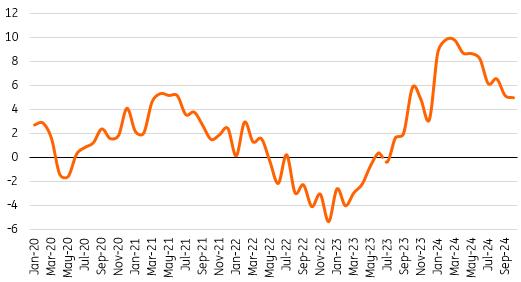
Polish Wage Growth Continues Easing As Labour Market Remains Tight
The average wage and salary in the Polish enterprise sector increased by 10.2% year-on-year in October (ING: 10.5%; consensus: 10.0%) following 10.3% YoY growth in September, reaching PLN 8,317 per month. The wage dynamics were supported by favourable calendar effects, while a high reference base in mining – where bonuses were paid in October 2023 – restrained growth.
In real terms (adjusted for inflation), wage growth in businesses slowed to 5.0% YoY from 5.2% YoY in September and nearly 10% YoY in the first quarter of 2024. Real wage growth has been systematically decreasing since the beginning of the year, and slowed down after the inflation rebound in July due to higher energy prices.
Household consumption growth was slower than the improvement in real disposable incomes in the first half of the year, indicating an increased propensity to save. In the second half, slower income growth was accompanied by a still-limited propensity to spend, and National Bank of Poland (NBP) surveys suggest that households are concerned about rising living costs in the future and are increasing their savings. This may be due to higher energy bills and negative experiences from 2023, when inflation significantly hit real incomes.
Wages growth moderates from its peak in 1Q24Real wage and salary in enterprises, %YoY

Source: GUS, ING
Average employment in businesses decreased by 0.5% YoY last month (ING and consensus: -0.5%), the same rate as in September. Compared to September, the enterprise sector lost 4,000 jobs. Aside from July, all other months of this year have seen a month-on-month decline in the number of jobs.
In some sectors, there are ongoing group layoffs (e.g., automotive, household appliances) but generally, the economy is still struggling with labour shortages due to unfavourable demographic trends and a deterioration in net migrations. The StatOffice indicates that factors boosting wages include overtime payments, suggesting that the demand for labour remains high while the main barrier is limited supply.
Employment continues to decline slightlyAverage paid employment in the enterprise sector, MoM thous. of persons
Source: GUSThe overall condition of Poland's labour market remains rather solid and unemployment is still near record-lows. The weakening of consumption seen in recent months is mainly due to behavioural factors (i.e., an increased propensity to save) rather than changes in household income situations.
We expect that consumption growth will be slower in 2025 than it was in 2024, and achieving economic growth in excess of 3% would require an investment rebound. This is indeed our baseline scenario as we see GDP growth of 3.5% in 2025. We anticipate that projects co-financed by structural funds and based on the EU's Recovery and Resilience Facility will commence.

Legal Disclaimer:
MENAFN provides the
information “as is” without warranty of any kind. We do not accept
any responsibility or liability for the accuracy, content, images,
videos, licenses, completeness, legality, or reliability of the information
contained in this article. If you have any complaints or copyright
issues related to this article, kindly contact the provider above.


















Comments
No comment